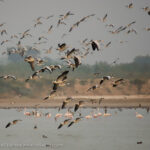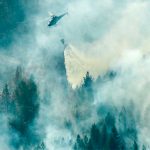IndiaWilds Newsletter Vol. 3 Issue IV
This issue of IndiaWilds Newsletter Vol. 3 Issue IV examines Tiger Census, Bamboo as minor forest produce and many more. This newsletter is available online. To view and to post your comments check at: http://www.indiawilds.com/diary/indiawilds-newsletter-vol-3-issue-iv
Tiger Census: Is it just a Numbers game?
Last month amid much fanfare, the Hon’ble Minister for MoEF announced the 2010 tiger census results. Interestingly, he was flanked by Planning Commission deputy chairman Shri Montek Singh Ahluwalia and water resources minister Shri. Salman Khurshid while making the announcement of the increase in tiger numbers to 1706. For details please check here: http://www.indiawilds.com/forums/showthread.php?p=31919#post31919
How correct are these estimations? The technique for estimating numbers have undergone a sea change. Initially the tiger population estimates was primarily based on casual estimates done by some experts like the 40,000 tiger numbers which was supposed to have come up during a casual discussion ( as mentioned by Dr. Salim Ali). Later the pug mark method was used to estimate the tiger population. It was another matter that this method was thoroughly abused by people either due to lack of knowledge in interpreting or due to ulterior motives. Of late, techniques like camera trapping and DNA finger printing show promise and has been used in some select resevers. We have come a long way in creating a process for scientifically estimating the population of wild tigers. However, we are yet to create a robust mechanism that includes proven scientific methodologies.
It is said that the previous census conducted in 2006 had thrown results with a considerably huge variance. The range, as officially declared, was 1165 to 1657. I am not sure who did the arithmetic, but 1411 ie. the simple average of the lower and higher limits was spoken about as the official wild tiger population. A high voltage awareness campaign by a private telecom operator – which was based on knowledge inputs provided by a leading wildlife NGO – cemented the 1411 number in public memory.
No wonder, in the recent census, the so called percentage increase in tiger numbers were based on this average figure of 1411.
It is another matter that this time there has been more areas included in the census. Nor did it worry people, that the methodology adopted is inconsistent across all territories. In some cases, images of tigers recorded in camera traps have been used where as in other cases it is not. Unless and until there is a consistent approach throughout, it will remain as much of an inexact science as the pugmark method it replaced.
It would be far better, if there are long term monitoring and studies in the tiger landscapes, so that rather than a one time effort, we can have consistent data across all regions. That would also help in conserving our wildlife and wilderness areas rather than the numbers approach in the present tiger census.
An important statistics that has emerged out of the tiger census is the loss in habitat to the tune of 20,000 kilometers. This is a phenomenal number. Not much has been discussed about it.
Interestingly, Shri Ramesh is supposed to have said – as reported by The Hindu – that “a country of 1.4 billion cannot survive on Solar, Wind and biogass alone, so we do need commercial sources of energy, but we also need to conserve these forests,” he told Mr. Ahluwalia. “We must decide whether we can afford a 9 percent growth agenda which would destroy our forests and the cultures and livelihoods that depend on them.”
A major part of the 20,000 sq. kilometers of the forest land lost is due to large infrastructure projects like dams, canals, airports, road building and increase in human habitations. Our urban planning has failed and has resulted in unequal and unsustainable growth of our mega cities. I hope the Deputy Chief of Planning Commission Shri Ahluwalia can give a thought to it.
Sadly, big is better seems to be the Mantra. So today we are turning a blind eye to the devastation unfolding in Fukushima Nuclear Power Plants in Japan and are pushing for a massive Nuclear Power Project in Jaitapur. More details can be found in the IndiaWilds Newsletter Vol 2 Issue III (http://www.indiawilds.com/diary/indiawilds-newsletter-vol-3-issue-iii ).
The ministers as well as the media were happily reporting the increase in tiger numbers. Numbers like 12% etc were thrown around and there were smiles in faces as if our conservation efforts have become an overnight success.
The Hon’ble Minister for MoEF was talking about sustaining a 9% year on year growth rate for the economy. However, he is happy at the so called 12% increase in estimated tiger population spread over 4 years. Since simple arithmetic has become the norm, perhaps he should have asked someone to do quickly compute the yearly percentage growth rate of tiger population. That might have had a sobering effect.
Though the census suggests that central India and Eastern Ghats have 601 tigers and Western Ghats have 534 tigers, the corridors in most of the areas have either been broken or under threat. Since none of the tiger reserves and the contiguous areas around those have a combined single population of 500 tigers – the minimum accepted number to have a genetically viable population – it is imperative that we focus on restoring the contiguities between various wilderness areas. That would help in replenishing the gene pool and maintaining the genetic diversity. The fact is tigers are prolific breeders and due to their tremendous instincts, given a chance, can repopulate areas. Last year a tiger from Ranthambhore managed to pass through sugar cane fields and sparse vegetation and reached Keoladeo Ghana National Park. Another managed to reach Kuno, though the contiguity has long been lost. So if the Hon’ble minister for MoEF and the Deputy Chairman of Planning commission and other ministers are serious, then we can certainly recreate those contiguous linkages.
However, given the fact that budgetary allocation for resettlement of villagers from tiger reserves is being reduced, I am not sure if the Dy. Chairman of Planning Commission Shri Ahluwalia is aware of the importance of recreating the linkages between wilderness areas and the importance of maintaining our amazing biodiversity.
A cursory look at the Planning Commission website makes for some interesting reading “The Planning Commission was set up by a Resolution of the Government of India in March 1950 in pursuance of declared objectives of the Government to promote a rapid rise in the standard of living of the people by efficient exploitation of the resources of the country, increasing production and offering opportunities to all for employment in the service of the community. The Planning Commission was charged with the responsibility of making assessment of all resources of the country, augmenting deficient resources, formulating plans for the most effective and balanced utilisation of resources and determining priorities. Jawaharlal Nehru was the first Chairman of the Planning Commission.” (Ref: History section)
When there is exploitation there is grief. The use of the word exploitation takes us to the so called “wood cutter” mentality which is far removed from preservation. The British with the sole idea to exploit had mercilessly cut down our forests and had planted many exotic species for timber. They had trained our foresters solely to exploit our forests. It is sad that even today we unknowingly retain the same wood cutter training of the British. It has been six decades since the Planning Commission was set up and it is unfortunate that Planning Commission hasn’t been able to truly appreciate the value of our natural heritage.
Probably, India can learn from Bolivia which is creating laws to establish 11 (eleven) new rights for nature, one of them being right of nature. The right of nature talks about “to not be affected by mega-infrastructure and development projects that affect the balance of ecosystems and the local inhabitant communities.” For further details please check here: http://www.indiawilds.com/forums/showthread.php?t=6461
The article 51A of our constitution states that “it shall be the duty of every citizen of India to protect and improve the natural environment including forests, lakes, rivers and wildlife, and to have compassion for living creatures.” Is it not the duty of the State too?
Until that realization dawns, tiger census will remain a mere statistical exercise.
Bamboo: Is it a tree or is it a grass?
Well, the Hon’ble Minister for MoEF seems to have woken up to the fact that bamboo belongs to the grass family. Whatever may be the scientific classification, bamboo has been historically treated by the forest department as a tree. The Hon’ble Minister has issued a letter to the states to treat bamboo as minor forest produce and allow the extraction of bamboo. He has asked for creation of management plans for commercial exploitation of bamboo.
Predictably, this has been welcomed by forest rights activists and has been described as a pro-people move. Cynics say that with the UPA Government completing two years and struggling to cope with the overload of scandals, this is perhaps a conscious decision to be seen as pro people. Since the wildlife doesn’t have a vote and our traditional economic models don’t value our rich biodiversity, it becomes an easy decision.
Bamboo is not just a grass or a minor forest produce like tendu and other such items. A clump of bamboo is like a mini ecosystem. It’s leaves are browsed by many herbivores. A large part of elephants diet comes from bamboo. Apart from giving the shade and shelter to carnivores like tigers, it also is the home to birds, rodents, reptile species and host of bugs and micro organisms. There is a complex chain of inter-relationships and removing one of the elements destabilizes the ecosystem. And here, we are talking about removing the parent (or host, so to speak) around which a micro-ecosystem is built. It might be pertinent to quote Sir Richard Attenborough, who says, “The best route to conservation is to save ecosystems.”
Of course, the proponents of this idea would jump to point out that the Hon’ble Minister for MoEF has mentioned that Gram Sabhas will develop management plans in consultation with the forest departments. Perhaps this is a bit late for an April Fool joke, however, in a country where the premier Tiger Reserves and National Parks work in an adhoc manner trying to dig a water hole here or burn down grasslands in another place or tie a couple of goats for an injured carnivore, their only actions are a series of short cuts rather than well thought out action plans. It is another matter that expecting each forest department officer to create long term management plans that have a sound ecological basis is nothing but foolishness as they are neither specifically trained for it, nor they do have the sufficient wherewithal’s to do it. There have been documented cases, when even our expert wildlife organizations have failed, not due to lack of intent, but these studies require an interdisciplinary approach and vision. The talk about the management plan in the Hon’ble Minister letter can at best serve as a handle to defend his order in the future when the devastation wrought by this order becomes apparent. It is a completely impractical idea.
Unfortunately, we humans as a race are perhaps the greediest of all and are not known for our foresight. And as Jane Goodall opines, in this panel discussion, “If you did a census of all species on earth as to which species would be the best one to disappear for the future sustainability of earth and it would be us.” For more details on it see here: http://www.indiawilds.com/forums/showthread.php?p=32087#post32087
Conservation:
Leopards attacking humans to be killed:
Recent guidelines to manage human-leopard conflict:
http://www.indiawilds.com/forums/showthread.php?t=6477
The Bannerghatta Night Safari:
The Karnataka Government’s plan to introduce night safari in Bannerghatta is now with the Supreme Court. For further details please check here: http://www.indiawilds.com/forums/showthread.php?t=2799
Dolphin Poaching:
There have been recent reports of dolphin poaching continuing as fishermen are using the oil from dolphins to catch fish. The tag of National Acquatic animal has brought no respite for it. If this continues, as is likely to be, then soon Ganga may follow the footsteps of Yangtze in losing its dolphin. For further details please check here: http://www.indiawilds.com/forums/showthread.php?t=6448
Impact of Pesticides:
One can no longer ignore the impact of pesticides. There has been recent reports of its impact on bees in UK (http://www.indiawilds.com/forums/showthread.php?t=6379 ). Another herbicide from Monsanto having Glyphosate has been found to be causing infertility and cancer (http://www.indiawilds.com/forums/showthread.php?t=6442 ).
Back here in India, the Government refuses to ban Endosulfan despite its documented impact on people. With India producing about 80% of the world production of endosulfan, the Governmet of India seems to be prioritizing business over people. If the studies conducted by the Ministry of Chemicals and Fertilizers is to be believed, trials of neem based pesticides conducted in tea estates and in other places have not only been successful, but it has also led to regeneration. That means it is acting as a fertilizer as well. In face of the powerful pesticides and fertilizer lobby, I doubt if neem based pesticides will ever be promoted. For further details please check here: http://www.indiawilds.com/forums/showthread.php?t=5539
Wildlife Photographers and Tunnel vision:
An interesting discussion started by Vikram Nanjappa. For further details please check here: http://www.indiawilds.com/forums/showthread.php?t=6388
Illegal Resort:
After reports of illegal housing schemes, now comes the report of an illegal resort coming up near Bandipur. For further details please check here: http://www.indiawilds.com/forums/showthread.php?t=6542
Natural History:
Striped Neck Mongoose feeding on Crocodile Eggs by Vikram Nanjappa : http://www.indiawilds.com/forums/showthread.php?t=6363
Wildlife Photography:
Images shared by our members between 10th March 2011 – 9th April, 2011 that depict interesting animal behaviour or are just plain beautiful.
A Jungle Cat trying to avoid being run over by Mohan Matang
http://www.indiawilds.com/forums/showthread.php?t=6366
Tiger with Langur by AB Apana
http://www.indiawilds.com/forums/showthread.php?t=6399
Lesser false vampire bats by Mohan Raj
http://www.indiawilds.com/forums/showthread.php?t=6386
Stags at War by Mrudul Godbole
http://www.indiawilds.com/forums/showthread.php?t=6398
Tiger Drinking by Dipankar Majumdar
http://www.indiawilds.com/forums/showthread.php?t=6264
Blue headed Rock Thrush by Dr. Jitendra Katre
http://www.indiawilds.com/forums/showthread.php?t=6356
Blackcrowned Sparrow Lark by Shreeram M. V
http://www.indiawilds.com/forums/showthread.php?t=6404
A good effort with a compact camera by Joshi Bhavya
http://www.indiawilds.com/forums/showthread.php?t=6355
Equipment discussions:
Filter
http://www.indiawilds.com/forums/showthread.php?t=6338
Benro Vs. Manfrotto Tripods
http://www.indiawilds.com/forums/showthread.php?t=6314
Canon launches two PL Mount Digital Cine zoom lenses with 4K capability
http://www.indiawilds.com/forums/showthread.php?t=6406
Canon launches 20x portable 2/3 inch HD Zoom lens with built in 2x capability
http://www.indiawilds.com/forums/showthread.php?t=6410
I look forward to your inputs and your support in preserving the last tracts of wilderness and wildlife left in this beautiful country. For other interesting articles and photographs please check:
http://www.indiawilds.com/forums/
The link to this Newsletter is available at: http://www.indiawilds.com/diary/indiawilds-newsletter-vol-3-issue-iv
All the newsletters can be found online at: http://www.indiawilds.com/diary/category/newsletter
In case, anyone of you has forgotten his/her user id and password can email the admin at the following email id administrator@indiawilds.com Others may register at www.indiawilds.com/forums/register.php
Regards,
Sabyasachi Patra
www.indiawilds.com
Profile: http://www.indiawilds.com/profile.htm
Contact: http://www.indiawilds.com/contact%20us.htm
Facebook: http://www.facebook.com/pages/IndiaWilds/132629240481
- GoPro Hero 12 Black - 6 September,2023
- Leopards: The Last Stand - 2 July,2023
- Drifting in the Waters of Sundarbans - 26 March,2023










